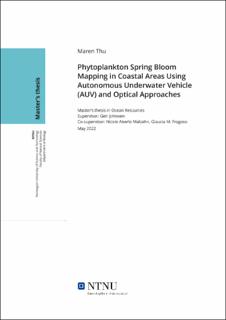| dc.contributor.advisor | Johnsen, Geir | |
| dc.contributor.advisor | Aberle-Malzahn, Nicole | |
| dc.contributor.advisor | Fragoso, Glaucia M. | |
| dc.contributor.author | Thu, Maren | |
| dc.date.accessioned | 2022-07-12T17:20:58Z | |
| dc.date.available | 2022-07-12T17:20:58Z | |
| dc.date.issued | 2022 | |
| dc.identifier | no.ntnu:inspera:101980170:23030101 | |
| dc.identifier.uri | https://hdl.handle.net/11250/3004866 | |
| dc.description.abstract | Fytoplankton danner oppblomstring over mesoskalaen (ofte <37 000 km2), og derfor er studier som har forskjelling oppløsning i tid og rom nødvendige. Ved å kombinere informasjon fra flere instrumentbærende plattformer, sensorer og datakilder kan det dannes en flerdimensjonal forståelse av naturen og dynamikken til algeoppblomstringen. Lokale fenomener kan hjelpe oss å forstå endringene som skjer i det globale miljøet, hvilket danner grunnlaget for hovedmålet med oppgaven, som var å kombinere «state-of-the-art» og tradisjonelle prøvetakingsmetoder for å studere algeoppblomstringsdynamikken i kystområder i Norge.
Resultatene fra denne oppgaven fungerer som verifisering for resultatene fra andre instrumentbærende plattformene (satellitt, fly og droner, alle utstyrt med hyperspektralt kamera (HI), ubemannet overflatefartøy (USV) og autonome undervannsfarkoster (AUV)). Vannprøvene gir også mer detaljert informasjon om dominerende pigmentgrupper. Konvensjonelle tilnærminger som kjemotaksonomi, mikroskopiske analyser og in vivo spektral reflektans antydet en dominans av kiselalger. In vivo reflektansspektre fungerer som en "validert" bio-optisk fytoplanktonsignatur, og kan brukes til å verifisere fjernmåling av algeoppblomstring i havoverflaten. Hovedbegrensningen ved bruk av satellitt- og fjernmålingsteknologier er at de kun observerer de øverste vannlagene, og mister verdifull informasjon om planktonfordelingen i de dypere vannlagene.
I denne studien ble en AUV brukt for å samle informasjon om fordelingen av klorofyll a-konsentrasjon, [Chl a], i vannsøylen, noe som komplementerer den romlige dekningen til satellittens fjernmåling. Det ble avdekket maksimale [Chl a] ved rundt 15 m for flere av innsamlingsdagene. Ved å kombinere informasjon fra vannsprøvene og AUV-sensorene, antyder resultatene observasjon av tre ulike oppblomstringsfaser (før oppblomstring, oppblomstring og etter oppblomstring). Forskjellen mellom in situ og in vitro estimater av [Chl a] kan skyldes den ujevne fordelingen av fytoplanktonbiomasse, ikke-fotokjemisk quenching (NPQ) av Chl a-fluorescens og lagdeling av vannmasser. SilCam-klassifiseringen mislyktes i å detektere og korrekt klassifisere "kiselalgerkjeder". Resultatene fra AUV-sensorene viste et behov for å undersøke optimalisering for datainnsamling ved bruk av miljøsensorer på fartøyet. Optiske tilnærminger og flerdimensjonal prøvetaking ved bruk av autonome undervannsfarkoster har gjennom denne oppgaven og tidligere utvikling, vist seg å ha et stort potensial for studier av algeoppblomstring. Tverrfaglig samarbeid fører til verdifull kunnskapsdeling, og forbedrer forståelsen av begrensninger og muligheter for algeoppblomstringsforskning. Videreutvikling av adaptiv prøvetakning, satellitter med HI og kunstig intelligens vil styrke dette forskningsområdet ytterligere. | |
| dc.description.abstract | Phytoplankton form mesoscale blooms (<37 000 km2), therefore studies covering different temporal and spatial resolutions are necessary. This is possible by combining information from different instruments-carrying platforms, sensors, and data sources forming a multidimensional understanding of the nature and dynamics of algal blooms. Local phenomena can help us understand changes in the global environment, hence, this thesis aimed to combine state-of-the-art and traditional sampling methods to study algal bloom dynamics in Norwegian coastal areas.
The result from this thesis serves as ground-truthing for other instruments-carrying platforms (satellites, aeroplanes, and drones all equipped with hyperspectral imager (HI), unmanned surface vehicle (USV) and autonomous underwater vehicle (AUV)) and provides detailed information about dominating pigment groups. Conventional approaches such as chemotaxonomy, microscopic analysis and in vivo spectral reflectance suggested dominance of diatoms. In vivo reflectance spectra serve as a “validated” phytoplankton bio-optical signature and can be used to verify remote sensing data of algal blooms in surface waters. The main limitation of using satellite and aerial remote sensing technologies is their constraints to observing the upper water column, missing valuable information about plankton distribution in the deeper water layers.
In this study, an AUV was used to collect information about the distribution of Chlorophyll a concentration, [Chl a], in the water column, complementing the spatial coverage of the satellite remote sensing. A sub-surface [Chl a] maximum was found around 15 meters for several of the fieldworks. By combining information from seawater samples and AUV sensors, the results suggest observation of three different bloom phases (pre-bloom, bloom, post-bloom) for the different fieldworks. The difference between in situ and in vitro estimations of [Chl a] may be due to the patchy distribution of phytoplankton biomass, non-photochemical quenching (NPQ) of Chl a fluorescence and the layering of the water masses. The silhouette camera (SilCam) classification failed to detect and correctly classify “diatom chains”. Results from the AUV sensors demonstrated a need to investigate best practices for operating the vehicle when environmental sensors are applied. Through previous development and the results of this thesis, optical approaches and multidimensional sampling using autonomous underwater vehicles have proven to provide a large potential for phytoplankton studies. Interdisciplinary research provides valuable knowledge sharing, improving the understanding of limitations and possibilities of conducting algal bloom research. Further development of adaptive sampling, satellites with HI, and artificial intelligence will enhance this area of research. | |
| dc.language | eng | |
| dc.publisher | NTNU | |
| dc.title | Phytoplankton spring bloom mapping in coastal areas using Autonomous Underwater Vehicle (AUV) and optical approaches | |
| dc.type | Master thesis | |
